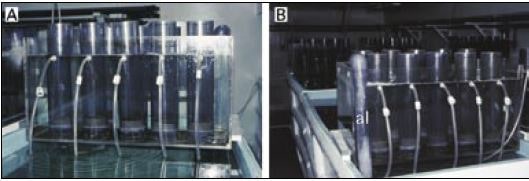6.3.4 Operation of closed upwelling systems
Upwelling is particularly useful in the culture of post-settlement oysters. Small spat are amenable to stocking in depth at high density, i.e. layered one above the other. The same applies to clam spat once they approach 0.5 mm in size.
Holding the small oysters in this way with a sufficient flow of water to fluidize the “bed” of spat prevents adjacent spat from fusing together to form clusters as they grow. Cluster formation can be a problem in Crassostrea species if the spat are not kept moving – for example, if they are grown in trays with a downwelling flow. This habit is more pronounced at the high water temperature, which is generally between 22 and 25oC for oyster spat growth. An upwelling flow is also more efficient in keeping the spat free of faecal deposits than is downwelling, where faeces tends to accumulate on and around the spat. This can result in blockage of the mesh, which is less of a problem in upwelling containers.

Figure 94: A and B – Closed upwelling systems in use for the growing of small oyster spat. The total volume of each tank unit is approximately 3 m3 and the spat holding tanks hold 10 cylinders each stocked with 60 g live weight of spat at the beginning of a weekly period.
The flexible outflow tubes from each cylinder are fitted with an adjustable clamp to permit individual control of flow rate. B – water is lifted from the reservoir to the holding tank by air-lift (al). This is a 5 cm diameter pipe with an airline fitted into the base. The flow of air into the bottom of the pipe lifts a sufficient volume of water to operate the system without the need for an electric pump.
Upwelling containers (referred to as cylinders or tubes) can be of varying diameter and they are made from sections of PVC or acrylic pipe fitted with nylon mesh bases of different aperture size for the range of sizes of spat grown. They do not need to be transparent as in Figure 94, but transparency is an advantage in gauging the flow rate required to fluidize the biomass (bed) of spat contained. The flow rate needed to fluidize, i.e. lift and circulate, the bed will depend on the size/weight of the spat and on the diameter of the pipe section. The larger the spat are the more flow will be needed to fluidize the bed. Lower flows are required in narrower cylinders. Typically, a flow of 1 or 2 l per minute through 5 or 10 cm diameter cylinders will fluidize a bed of 1 to 3 mm oyster spat. A flow of between 25 and 40 ml per minute per g of spat is ideal. Beds of clam spat, which embyss together, will not fluidize. Nevertheless the method works just as well as it does with oysters. Possibly the effect of spat being aggregated together is advantageous in that it simulates conditions when they are buried in substrate. Beds of clam spat – tightly embyssed together – when held in downwelling conditions tend to act as sediment traps and meshes soon become blocked.
The numbers of spat that can be held in an upwelling tank system depends on their size/weight (Table 14). Take, for example, the system shown in Figure 94 in which the combined volume of each reservoir and spat holding tank unit is close to 3 000 l. There are 16 similar units in the hatchery. Each unit is suitable for growing a live weight biomass of 600 g. Assuming the spat to be grown are 2 mm shell length, reference to Table 14 indicates that 272 700 spat of this size will make up the initial biomass. The holding tank shown in Figure 94 contains 10, 10 cm diameter cylinders. At the beginning of a 7-day period, each cylinder is stocked with 600/10 = 60 g of spat. These will have been graded using a 1.5 mm mesh screen over another screen of 1 mm aperture upon which they will have been retained (2mm spat will not be retained by a 1.5 mm mesh). In this context, the relevance of accurately knowing the numbers of spat stocked in a unit is superseded by the importance of knowing their biomass. For further explanation see section 6.3.5.
Seawater to fill the tank units is filtered and heated to larval culture standards for spat in their first week after set. After that time, they are filled with either sand-filtered or 10 or 20 ?m cartridge filtered water and the temperature is decreased by 1 or 2oC per week to start acclimation to prevailing conditions in the nursery or sea.
At the end of the 7-day period, during which time the tank volume will have been changed twice and the spat and system cleaned at each water change, the spat are graded and redistributed again. The 600 g biomass at the beginning of the week will have doubled or even trebled for oysters by the end of the 7-day period and so will need to be redistributed between two or three 3 000 l units to grow for a further week. Spat will not have grown evenly in size during the previous week. By grading through a stack of screens production from the tank unit can be size fractionated (section 6.3.6). The growing process functions more efficiently if spat of the different size fractions (grades) are grown in separate tank units so that those in any one unit are of the same size grade.